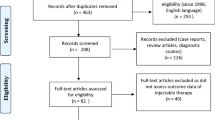Summary
Recent innovative research into the physiology and pharmacology of erection and the introduction of intracavernous injection of vasoactive agents have revolutionised our approach to the diagnosis and treatment of impotence. A thorough understanding of the rationale, indications, precautions and potential complications of intracavernous self-injection is essential for successful management.
The commonly used drugs for injection are papaverine, either alone or in combination with phentolamine, and alprostadil (prostaglandin E1). The major adverse effects include priapism, prolonged erection, and fibrosis of the erectile tissue. With the proper technique and appropriate dosage, this is a safe, minimally invasive, and highly effective treatment.
Similar content being viewed by others
References
Aboseif SR, Breza J, Bosch RJLH, Bernard F, Stief CG, et al. Local and systemic effects of chronic intracavernous injection of papaverine, prostaglandin E1, and saline in primates. Journal of Urology 142: 403–408, 1989
Brindley GS. Cavernosal alpha-blockade: a new technique for investigating and treating erectile impotence. British Journal of Psychiatry 143: 332–337, 1983
Ishii N, Watanabe H, Irisawa C, Kikuchi Y, Kawamura S, et al. Studies on male sexual impotence. Report 18: therapeutic trial with prostaglandin E1 for organic impotence. Japanese Journal of Urology 77: 954–962, 1986
Juenemann KP, Lue TF, Fournier Jr GR, Tanagho EA. Hemodynamics of papaverine-and phentolamine-induced penile erection. Journal of Urology 136: 158–161, 1986
Keogh EJ, Watters GR, Earle CM, Carati CJ, Wisniewski ZS, et al. Treatment of impotence by intrapenile injections. A comparison of papaverine and phentolamine: a double-blind, crossover trial. Journal of Urology 142: 726–728, 1989
Robinson LQ, Stephenson TP. Self injection treatment for impotence. British Medical Journal 299: 1568, 1989
Sidi AA, Cameron JS, Duffy LM, Lange P. Intracavernous drug induced erection in the management of male erectile dysfunction: experience with 100 patients. Journal of Urology 135: 704–706, 1986
Sidi AA, Cameron JS, Duffy LM, Lange P. Patient acceptance of and satisfaction with vasoactive intracavernous pharmacotherapy for impotence. Journal of Urology 140: 293–294, 1988
Stackl W, Hasun R, Marberger M. Intracavernous injection of prostaglandin E1 in impotent men. Journal of Urology 140: 66–68, 1988
Virag R. Intracavernous injection of papaverine for erectile failure. Correspondence. Lancet 2: 938, 1982
Zorgniotti AW, Lefleur RS. Auto-injection of corpus cavernosum with a vasoactive drug combination for vasculogenic impotence. Journal of Urology 133: 39–41, 1985
Author information
Authors and Affiliations
Rights and permissions
About this article
Cite this article
Bénard, F., Lue, T.F. Self-Administration in the Pharmacological Treatment of Impotence. Drugs 39, 394–398 (1990). https://doi.org/10.2165/00003495-199039030-00006
Published:
Issue Date:
DOI: https://doi.org/10.2165/00003495-199039030-00006




